Differential regulation of endocannabinoid synthesis and degradation in the uterus during embryo implantation
- PMID: 17259073
- PMCID: PMC1805469
- DOI: 10.1016/j.prostaglandins.2006.09.009
Differential regulation of endocannabinoid synthesis and degradation in the uterus during embryo implantation
Abstract
Preimplantation embryo development to the blastocyst stage and uterine differentiation to the receptive state are prerequisites for embryo implantation. Burgeoning evidence suggests that endocannabinoid signaling is critical to early pregnancy events. Anandamide (N-arachidonoylethanolamine) and 2-AG (2-arachidonoylglycerol) are two major endocannabinoids that bind to and activate G-protein coupled cannabinoid receptors CB1 and CB2. We have previously shown that a physiological tone of anandamide is critical to preimplantation events in mice, since either silencing or amplification of anandamide signaling causes retarded development and oviductal retention of embryos via CB1, leading to deferred implantation and compromised pregnancy outcome. Whether 2-AG, which also influences many biological functions, has any effects on early pregnancy remains unknown. Furthermore, mechanisms by which differential uterine endocannabinoid gradients are established under changing pregnancy state is not clearly understood. We show here that 2-AG is present at levels one order of magnitude higher than those of anandamide in the mouse uterus, but with similar patterns as anandamide, i.e. lower levels at implantation sites and higher at interimplantation sites. We also provide evidence that region- and stage-specific uterine expression of N-acylphosphatidylethanolamine-specific phospholipase D (NAPE-PLD) and fatty acid amide hydrolase (FAAH), and sn-1-diacylglycerol (DAG) lipase alpha (DAGLalpha) and monoacylglycerol lipase (MAGL) for synthesis and hydrolysis of anandamide and 2-AG, respectively, creates endocannabinoid gradients conducive to implantation. Our genetic evidence suggests that FAAH is the major degrading enzyme for anandamide, whereas COX-2, MAGL and to some extent COX-1 participate in metabolizing 2-AG in the pregnant uterus. The results suggest that aberrant functioning of these pathways impacting uterine anandamide and/or 2-AG levels would compromise pregnancy outcome.
Figures

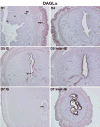
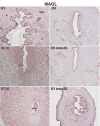
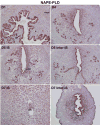
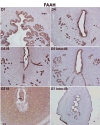
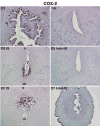

Similar articles
-
Fatty acid amide hydrolase deficiency limits early pregnancy events.J Clin Invest. 2006 Aug;116(8):2122-31. doi: 10.1172/JCI28621. J Clin Invest. 2006. PMID: 16886060 Free PMC article.
-
Endocannabinoid dysregulation in the pancreas and adipose tissue of mice fed with a high-fat diet.Obesity (Silver Spring). 2008 Mar;16(3):553-65. doi: 10.1038/oby.2007.106. Epub 2008 Jan 17. Obesity (Silver Spring). 2008. PMID: 18239598
-
The uterus is a potential site for anandamide synthesis and hydrolysis: differential profiles of anandamide synthase and hydrolase activities in the mouse uterus during the periimplantation period.Mol Reprod Dev. 1996 Oct;45(2):183-92. doi: 10.1002/(SICI)1098-2795(199610)45:2<183::AID-MRD11>3.0.CO;2-2. Mol Reprod Dev. 1996. PMID: 8914076
-
New insights into endocannabinoid degradation and its therapeutic potential.Mini Rev Med Chem. 2006 Mar;6(3):257-68. doi: 10.2174/138955706776073466. Mini Rev Med Chem. 2006. PMID: 16515464 Review.
-
Biology of endocannabinoid synthesis system.Prostaglandins Other Lipid Mediat. 2009 Sep;89(3-4):112-9. doi: 10.1016/j.prostaglandins.2008.12.002. Epub 2008 Dec 14. Prostaglandins Other Lipid Mediat. 2009. PMID: 19126434 Review.
Cited by
-
Histomorphometric evaluation of cannabinoid receptor and anandamide modulating enzyme expression in the human endometrium through the menstrual cycle.Histochem Cell Biol. 2010 May;133(5):557-65. doi: 10.1007/s00418-010-0695-9. Epub 2010 Apr 6. Histochem Cell Biol. 2010. PMID: 20369362
-
Cannabis Use in Pregnant and Breastfeeding Women: Behavioral and Neurobiological Consequences.Front Psychiatry. 2020 Nov 2;11:586447. doi: 10.3389/fpsyt.2020.586447. eCollection 2020. Front Psychiatry. 2020. PMID: 33240134 Free PMC article. Review.
-
Serine Hydrolases in Lipid Homeostasis of the Placenta-Targets for Placental Function?Int J Mol Sci. 2022 Jun 20;23(12):6851. doi: 10.3390/ijms23126851. Int J Mol Sci. 2022. PMID: 35743292 Free PMC article. Review.
-
Roles of lipid mediators in early pregnancy events.Reprod Med Biol. 2024 Jul 15;23(1):e12597. doi: 10.1002/rmb2.12597. eCollection 2024 Jan-Dec. Reprod Med Biol. 2024. PMID: 39010880 Free PMC article. Review.
-
Opposite effects of methanandamide on lipopolysaccharide-induced prostaglandin E2 and F2α synthesis in uterine explants from pregnant mice.PLoS One. 2012;7(7):e39532. doi: 10.1371/journal.pone.0039532. Epub 2012 Jul 5. PLoS One. 2012. PMID: 22792180 Free PMC article.
References
-
- Wang H, Dey SK. Roadmap to embryo implantation: clues from mouse models. Nat Rev Genet. 2006;7:185–199. - PubMed
-
- Dey SK, Lim H, Das SK, Reese J, Paria BC, Daikoku T, Wang H. Molecular cues to implantation. Endocr Rev. 2004;25:341–373. - PubMed
-
- Paria BC, Dey SK. Ligand-receptor signaling with endocannabinoids in preimplantation embryo development and implantation. Chem Phys Lipids. 2000;108:211–220. - PubMed
Publication types
MeSH terms
Substances
Grants and funding
LinkOut - more resources
Full Text Sources
Other Literature Sources
Research Materials

